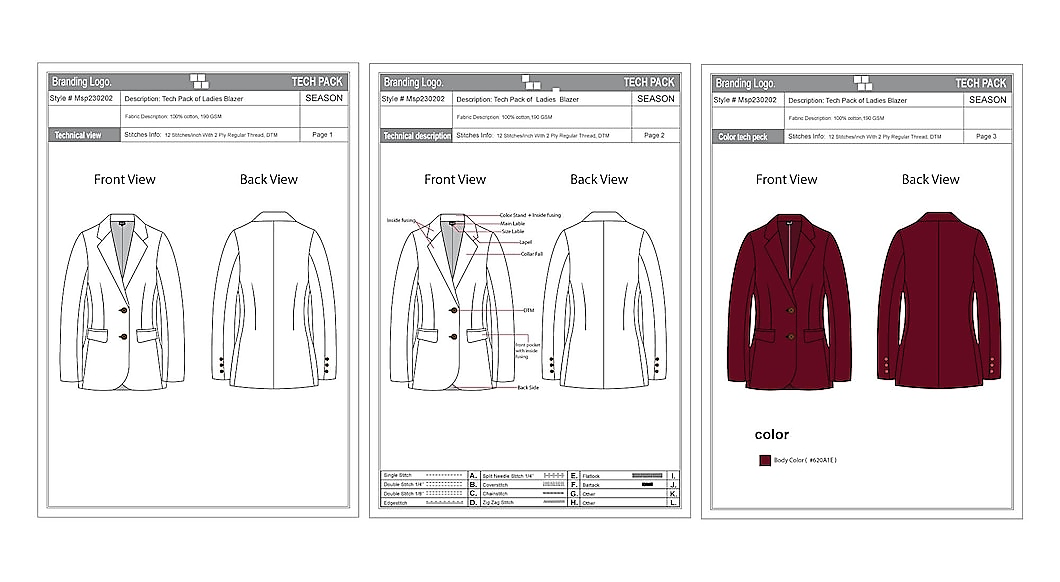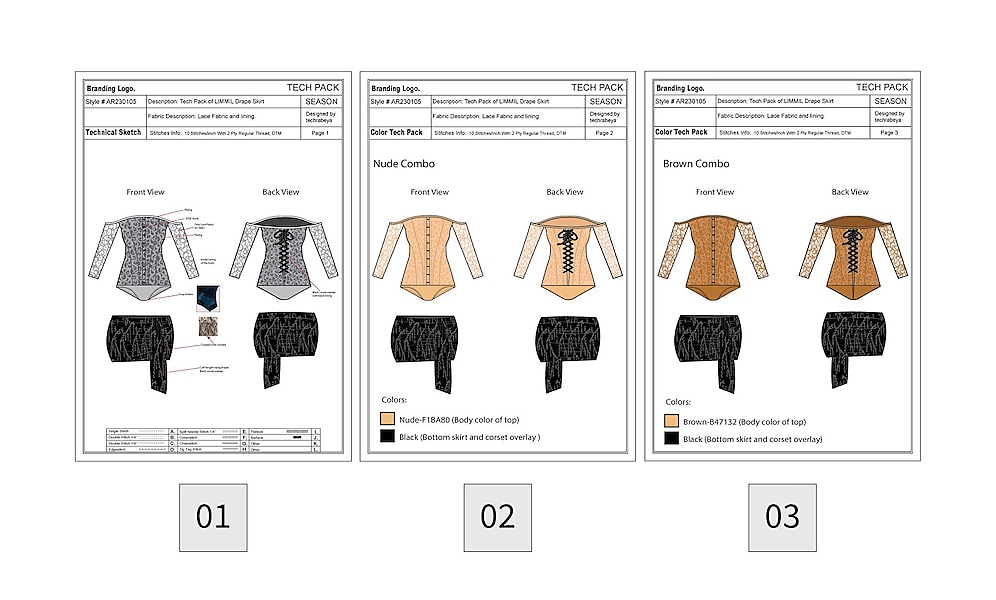What Is Taffeta Fabric? A Complete Guide to Properties of Taffeta, How Taffeta Is Made, and Where It Comes From
When you ask, “What is taffeta fabric?” You’re asking about a textile...
You’ve spent months sketching, sewing, and perfecting your collection, and now it’s time to discover how to create a line sheet to unveil your designs to buyers. But before you can land those lucrative retail accounts, you need to create a professional fashion line sheet to showcase your brand.
Putting together an eye-catching yet informative line sheet is key to getting your foot in the door with stores. It allows buyers to quickly evaluate your collection and determine if it’s the right fit for their customers. If done right, a fashion line sheet can make or break a new designer’s success each season. With your line sheet, are you unsure of where to begin? This is all the information you require to design a fashion line sheet that will entice buyers to place orders.
What is a line sheet in fashion? A fashion line sheet is a visual representation of starting your clothing line that provides all the details buyers need to place orders. It includes photos of each garment along with descriptions, pricing, size ranges, and material details.
To create an effective line sheet:
A well-crafted line sheet is essential for presenting your collection to boutiques, online retailers, and stylists. By providing all the details they need, you make it easy for them to envision how they can sell your pieces, and you’ll increase your chances of getting orders!
To create an effective fashion line sheet, you’ll want to include some essential elements.

High-quality photos of each item in your collection are a must. Include front, back, and detail shots so buyers get a complete sense of the product. Zoom in on any special details or embellishments.
For each item, include a 1-2 sentence description highlighting the key features, fabric, silhouette, and any standout details. Mention the item’s “wow factor” to grab attention.
Provide exact garment measurements for each size so buyers know how the item will fit their customers. List shoulder, bust, waist, and hip measurements for dresses and separates. For footwear, include heel height, platform height, and shaft circumference.
Indicate the wholesale and suggested retail price for each item so buyers understand your price points and profit margins.
Specify your delivery timeframe, minimum order quantities, shipping, and return policies so buyers know exactly what to expect. Be as transparent as possible to build trust.
Following these tips will result in a polished, professional line sheet that effectively showcases your collection and sets the right expectations for buyers. With high-quality images, thoughtful descriptions, and clear terms, you’ll have a greater chance of converting sales and building strong retail partnerships.
A well-designed layout is key to creating an eye-catching line sheet. Here are some tips to make your line sheet visually appealing:
Include high-resolution photos of each garment or accessory in your collection. Place the photos prominently at the top of each item’s description. Potential buyers want to see what the pieces look like. Make sure photos are well-lit, in focus, and show the full item.
Provide information like fabric content, size range, color options, and wholesale or retail price points for each item. Be specific about materials to attract buyers looking for certain textiles. List the exact measurements and sizing for the best fit.
Select a large font, approximately 12 points in size, that is clear and simple, such as Arial, Helvetica, or Calibri. This makes your line sheet easy to read, whether printed or viewed digitally. Use bolding, italics, or underlining sparingly for emphasis.
Don’t crowd your line sheet. Use double spacing between paragraphs and leave margins of at least 0.5 inches on all sides. This gives the reader’s eyes a rest and allows important information to stand out.
Feature your logo prominently at the top of each page to reinforce your brand identity. This also gives your line sheet a professional, polished look and feel.
Add pops of color to draw attention to your photos, brand name, section headings, or other important elements. But don’t overdo it, or your line sheet may seem too busy. In general, limit color use to no more than three complementary hues.
Keeping these tips in mind will result in an attractive, cohesive line sheet that effectively showcases your collection. An eye-catching layout combined with detailed product information gives buyers everything they need to confidently place an order.
Once you have the key details of your line sheet established, it’s time to use it to tell the story of your brand and seasonal collection. Think of your line sheet as a visual representation of your brand’s vision and voice.
Your line sheet is a chance to express your brand’s style and image. Use your brand’s fonts, colors, and logo prominently on the cover and header of each page. Select imagery that is consistent with your brand’s visual identity and aspirational lifestyle. Everything, from the layout to the language you use, should reflect your brand’s personality.
Call out what makes your collection unique through both images and descriptions. Focus on special details like custom prints, innovative silhouettes, or luxury fabrics. Draw attention to your brand’s design perspective and key seasonal influences or themes. Discuss how your pieces can be incorporated into customers’ wardrobes and lifestyles.
Give buyers insight into your creative process and the inspiration behind the collection. Explain the unique characteristics of key pieces, like limited edition runs or handcrafted elements. Discuss sourcing details for premium materials or custom components. Helping buyers understand the care, craftsmanship, and thought that went into your products will make them more valued and coveted.
Suggest how buyers can merchandise your collection for maximum impact and sales. Provide a visual line sheet with examples of key looks or outfits. Recommend how to group complementary pieces. Discuss which products would be most suitable for window displays or editorial coverage. Offer tips on how best to style your pieces for your target customers. Providing merchandising guidance shows you understand how to help buyers optimize your collection.
Your line sheet is a chance to share the story of your brand and collection with buyers. By expressing your brand identity, highlighting your key products, explaining your design focus, and providing merchandising tips, you give buyers insight into your creative vision and help them better understand the value of your collection. Use it to build excitement for your line and set the right context for your product.
Once your line sheet is designed and ready to share, follow these best practices for maximum exposure:

In today’s digital age, the most effective way to distribute your line sheet is electronically. Email the line sheet as an attachment to buyers, retailers, influencers, and media contacts. Also, post the line sheet on your website and social media platforms like Instagram to allow customers and partners to view and download it.
Make sure you have a comprehensive contact list of key buyers, retailers, influencers, and media in your target market. Do research to find contacts at major department stores, boutiques, online retailers, and fashion media. Build rapport and connections with them over time through social media, emails, and in-person meetings. When your new line sheet is ready, they’ll be eager to view it.
Don’t just blast your line sheet to everyone on your list. Personalize emails for each contact, mentioning specific products you think would resonate with their customers or fit well in their store. Explain the inspiration and highlights of your new collection. This personal touch will make them much more likely to take the time to review your line sheet.
Be prompt and professional with your follow-up to anyone who views or downloads your line sheet. Thank them for their interest and time. Let them know you’re available to provide clothing sample production, answer questions about products, or schedule a call to discuss the collection further. Your professionalism and persistence can lead to new stockists and sales.
While digital is best, some buyers and media still prefer print line sheets. Print a few high-quality copies of your line sheet to have on hand for in-person meetings and events. Place print line sheets in media gift bags at fashion shows or send them as a follow-up to key contacts. The tangible component can make an impact.
With a well-crafted line sheet and smart distribution strategy, you’ll gain valuable exposure for your fashion brand and open doors to new opportunities. Follow these tips and your line sheet is sure to impress!
A line sheet provides buyers with the details of your collection, while a sell sheet aims to persuade them to purchase from your line. Think of a line sheet as an overview of what you’re offering each season, and a sell sheet as your sales pitch to stores.
When creating a line sheet, focus on the facts: provide photos of each style, exact product specs like fabric content, available sizes, and wholesale and retail price points. Keep descriptions concise while highlighting key details. A line sheet gives buyers the full picture of your line so they know exactly what they’re ordering.
On the other hand, a sell sheet markets your brand aesthetic and persuades buyers that your line will sell. Include lifestyle images showing how the pieces can be styled and worn. Share details about your target customer and brand story to build connections. Discuss the current fashion trends your line taps into. A sell sheet generates excitement about your collection and motivates buyers to place an order.
At the end of the day, a line sheet informs while a sell sheet inspires. Providing both gives buyers everything they need to make a confident purchasing decision and invest in your line. You’ll find most brands offer both a comprehensive line sheet and an eye-catching sales sheet each season. Together, they set you up for success and spread the word about your latest collection.
Line sheets are essential tools for any fashion designer. They provide many benefits to help you promote your collection and gain interest from buyers.
For starters, a well-designed line sheet gives an organized overview of your entire collection. It shows each item you have to offer for the season: apparel line sheets, accessories, shoes, handbags, etc. Buyers can quickly see all the details for each product, like colors, sizes, pricing, and images. This makes it easy for them to understand your brand and place orders.
Line sheets are also a convenient way to share your latest designs with buyers. Rather than meeting with each buyer individually, you can email or mail your line sheet to reach many potential customers at once. This saves you valuable time and resources. Buyers appreciate receiving line sheets too, since they can review collections on their schedule.
An attractive, professional line sheet builds credibility for your fashion label. It shows buyers that you have a cohesive, well-thought-out collection and are serious about your business. This gives them confidence in the quality and value of your products.
Fashion line sheets provide organization, convenience, and credibility. They are essential for promoting your collection to buyers and gaining valuable orders to drive your fashion business forward. Creating an eye-catching line sheet is time well spent.
How do I make a line sheet? You’ve put in the work of sketching, sourcing, and sampling; now it’s time to share your collection with the world. A fashion linesheet is your chance to showcase all the details that make your pieces special. Buyers will be lining up to carry your brand if you have precise descriptions, gorgeous photos, and a well-designed layout. Never forget to think creatively and authentically about your vision. The fashion industry needs creative minds, so do your thing!